
Product Led Growth (PLG) vs. Traditional Sales-Led Growth

by
Wiktoria Slowikowska
Oct 10, 2024
Identify and convert your most valuable users
Sign Up
Choosing the right growth strategy can make all the difference between thriving and merely surviving. Two approaches have risen to prominence: Product-Led Growth (PLG) and traditional sales-led growth. As a SaaS leader, understanding the nuances of these strategies is crucial for steering your company towards sustainable success.
Let's dive deeper into these approaches, exploring their intricacies, benefits, and potential challenges.
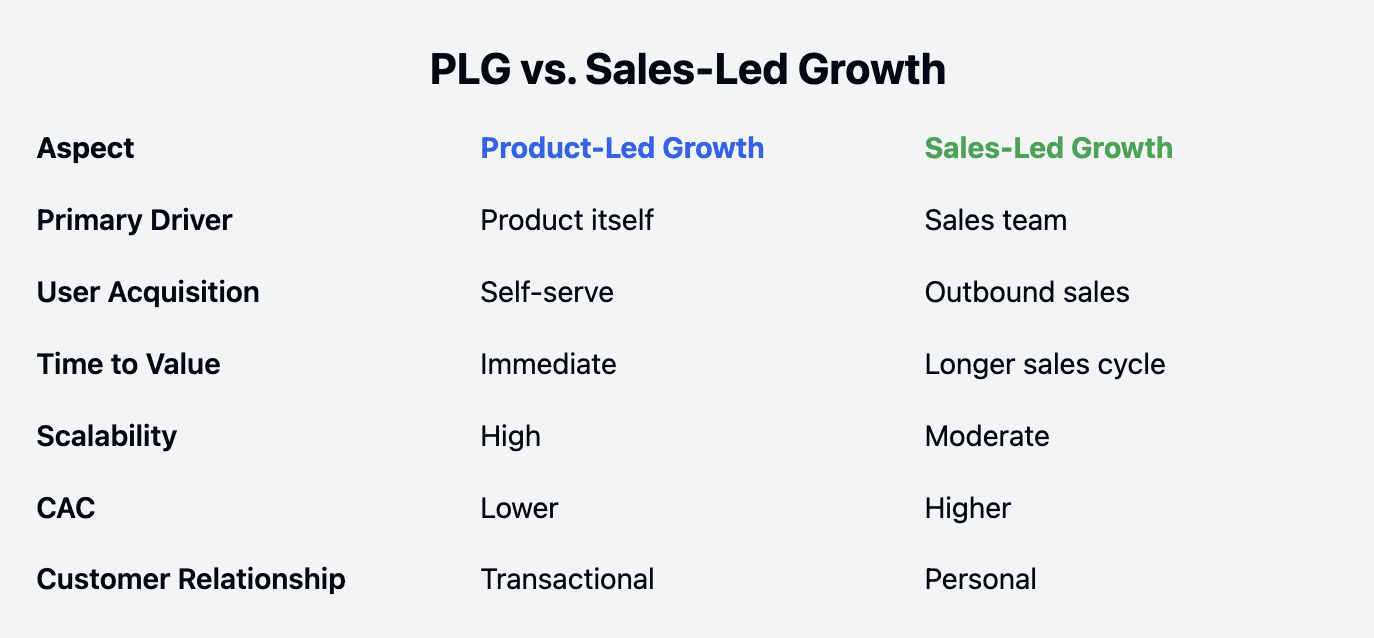
Product-Led Growth
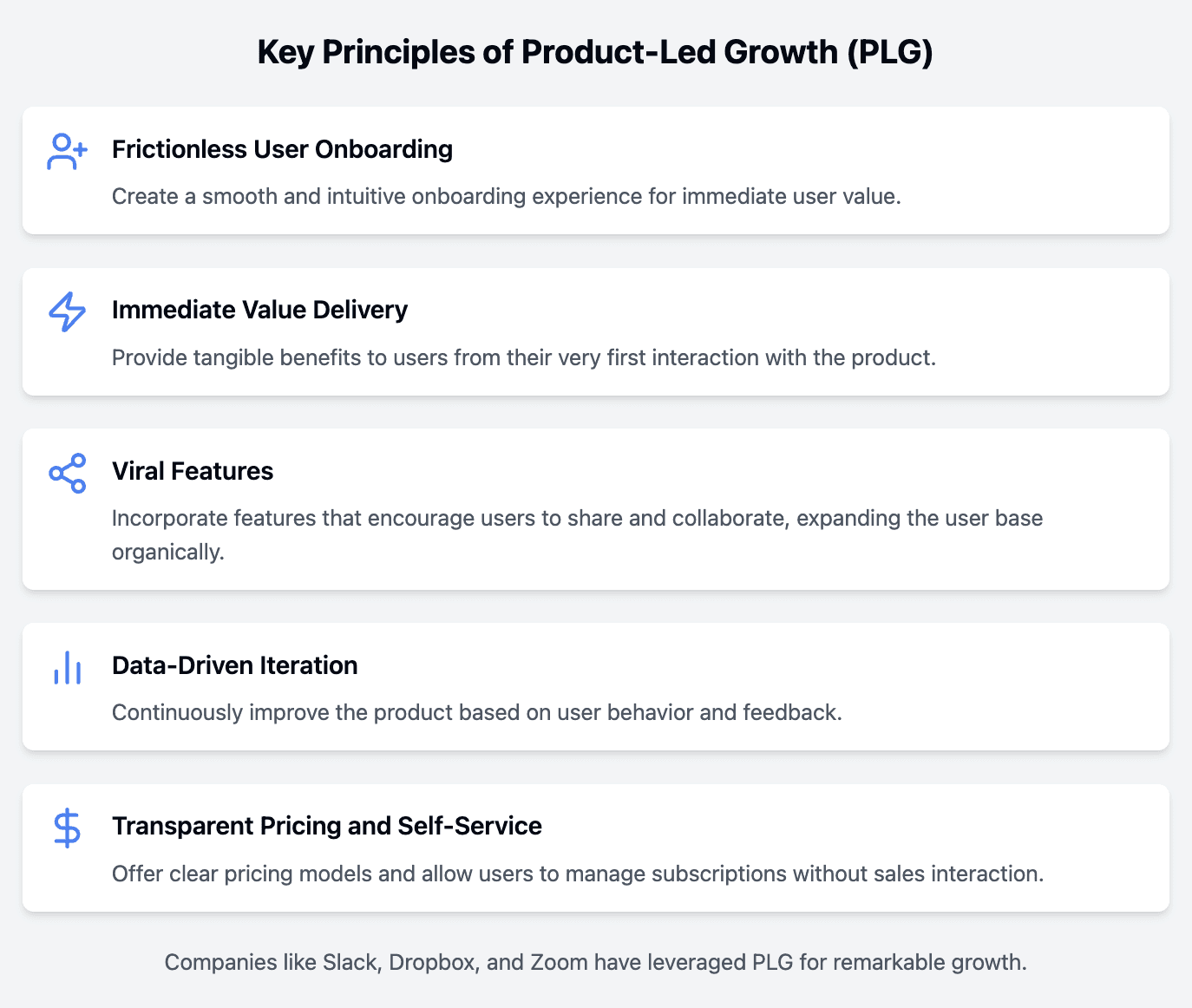
Product-Led Growth, or PLG, represents a paradigm shift in how SaaS companies approach customer acquisition and retention. At its core, PLG positions the product itself as the primary driver of growth. This strategy is built on the premise that a truly exceptional product can serve as its own best marketing and sales tool.
Key Principles of PLG:
Frictionless User Onboarding: PLG companies prioritize creating an onboarding experience so smooth and intuitive that users can derive value from the product almost immediately.
Immediate Value Delivery: The focus is on providing tangible benefits to users from their very first interaction with the product.
Viral Features: PLG products often incorporate features that naturally encourage users to share or collaborate, thereby organically expanding the user base.
Data-Driven Iteration: Continuous product improvement based on user behavior and feedback is a hallmark of the PLG approach.
Transparent Pricing and Self-Service: PLG companies typically offer clear, accessible pricing models and allow users to upgrade or modify their subscriptions without interacting with a sales representative.
Companies like Slack, Dropbox, and Zoom have leveraged PLG to achieve remarkable growth trajectories. These success stories have inspired many SaaS startups to adopt this model, attracted by its potential for rapid scaling and lower customer acquisition costs.
The PLG User Journey:
In a PLG model, the typical user journey might look something like this:
Discovery: A potential user learns about the product, often through word-of-mouth or organic search.
Free Trial or Freemium Access: The user signs up for a free trial or starts with a free plan.
Onboarding: The user is guided through key features, often with in-app tutorials or tooltips.
Value Realization: The user begins to experience the benefits of the product in their workflow.
Expansion: Satisfied with the value, the user upgrades to a paid plan or expands usage within their organization.
Advocacy: The user becomes a product advocate, recommending it to colleagues or peers.
Traditional Sales-Led Growth
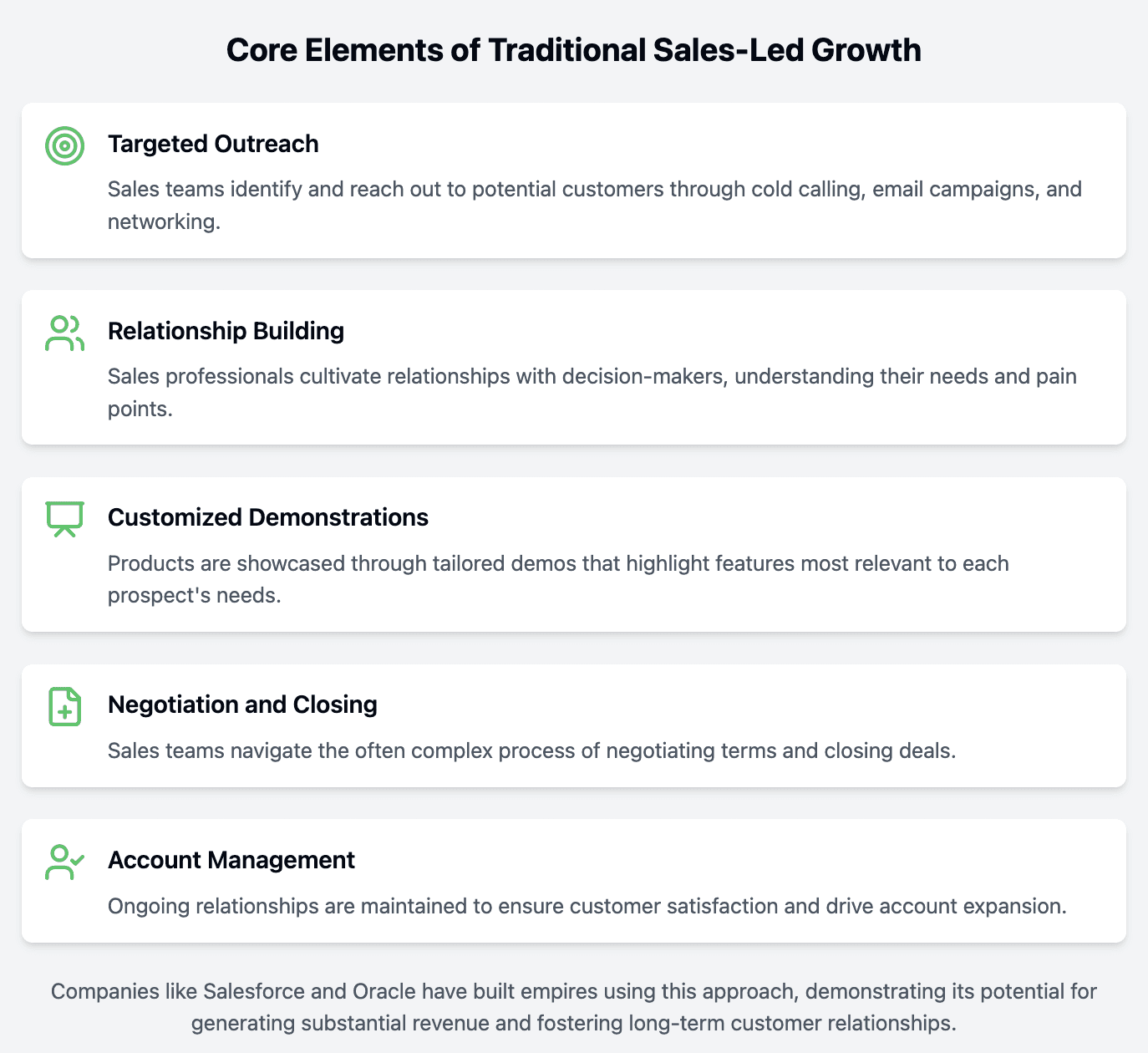
On the other side of the spectrum, we have the traditional sales-led growth model. This approach has been the backbone of the software industry for decades and continues to be effective, particularly for complex, high-value solutions.
Core Elements of Sales-Led Growth:
Targeted Outreach: Sales teams identify and reach out to potential customers, often using a combination of cold calling, email campaigns, and networking.
Relationship Building: Sales professionals cultivate relationships with decision-makers, understanding their needs and pain points.
Customized Demonstrations: Products are showcased through tailored demos that highlight features most relevant to each prospect's needs.
Negotiation and Closing: Sales teams navigate the often complex process of negotiating terms and closing deals.
Account Management: Ongoing relationships are maintained to ensure customer satisfaction and drive account expansion.
Companies like Salesforce and Oracle have built empires using this approach, demonstrating its potential for generating substantial revenue and fostering long-term customer relationships.
The Sales-Led User Journey:
In a sales-led model, the customer journey typically follows this path:
Prospecting: Sales teams identify potential customers through various channels.
Initial Contact: A sales representative reaches out to introduce the product and gauge interest.
Needs Assessment: The sales team works to understand the prospect's specific requirements and challenges.
Product Demonstration: A tailored presentation or demo is delivered to showcase how the product addresses the prospect's needs.
Proposal and Negotiation: A formal proposal is presented, often followed by negotiations on pricing and terms.
Closing: The deal is finalized, and contracts are signed.
Onboarding and Account Management: The customer is onboarded, and an account manager takes over to ensure ongoing satisfaction and identify expansion opportunities.
Comparing PLG and Sales-Led Growth
To make an informed decision about which strategy is right for your SaaS company, it's essential to understand how these approaches compare across various dimensions:
Customer Acquisition Costs (CAC): PLG typically boasts lower CAC due to its self-serve nature and reliance on the product to drive adoption. Sales-led approaches often involve higher costs associated with maintaining sales teams and supporting their activities.
Scalability: PLG offers superior scalability, allowing companies to grow their user base rapidly without a proportional increase in headcount. Sales-led growth can face challenges in scaling efficiently, as expanding often requires hiring and training new sales personnel.
Time to Value: PLG aims to provide immediate value to users, often allowing them to start using the product within minutes of signing up. Sales-led approaches may have longer time-to-value due to extended sales cycles and implementation processes.
Customer Relationship Management: Sales-led growth often results in stronger, more personal relationships with customers, which can be particularly valuable for complex products or in industries where high-touch service is expected. PLG relationships can be more transactional but may achieve greater scale.
Revenue Predictability: Traditional sales models often provide more predictable revenue forecasts due to pipeline visibility and longer contract commitments. PLG can lead to more variable, albeit potentially higher, growth rates.
Market Penetration: Sales-led approaches can be more effective at penetrating enterprise markets where decision-making processes are complex and involve multiple stakeholders. PLG excels in markets where individual users or small teams can make purchasing decisions.
Product Complexity: Highly complex products or those requiring significant customization often benefit from a sales-led approach, where sales teams can guide customers through the intricacies. More intuitive, out-of-the-box solutions are well-suited to PLG.
Feedback Loop: PLG companies often have a more direct and immediate feedback loop from users to product teams, facilitating rapid iteration. Sales-led companies may rely more on feedback filtered through sales and customer success teams.
Factors to Consider When Choosing Your Strategy
The right growth strategy for your SaaS company depends on various factors:
Product Complexity: Assess the learning curve and customization requirements of your product.
Target Market: Consider whether you're primarily targeting B2C, SMB, or enterprise customers.
Average Deal Size: Larger deal sizes typically justify the investment in a sales team, while smaller deals benefit from the efficiency of PLG.
Sales Cycle Length: Evaluate the typical length of your sales cycle and how it aligns with each approach.
Resources and Team Structure: Consider your current team composition and the resources required to implement each strategy effectively.
Industry Norms: Some industries have established expectations around how software is bought and sold.
Competitive Landscape: Analyze how your competitors go to market and whether there's an opportunity to differentiate through your growth strategy.
The Rise of Hybrid Models
Increasingly, SaaS companies are recognizing that PLG and sales-led growth are not mutually exclusive. Many are adopting hybrid models that combine elements of both approaches. This strategy allows companies to leverage the efficiency of PLG for user acquisition and initial adoption, while employing sales teams to drive enterprise adoption, handle complex use cases, and focus on expansion revenue.
Companies like Atlassian have successfully implemented hybrid models. They use a PLG approach to drive initial adoption among developers and small teams, while maintaining a sales force to support larger enterprise customers and drive expansion within those accounts.
Implementing a hybrid model requires careful orchestration:
Clear Segmentation: Define which customer segments will be served by PLG versus sales-led approaches.
Seamless Handoffs: Establish processes for transitioning customers from self-serve to sales-assisted journeys when appropriate.
Aligned Incentives: Ensure that compensation structures encourage collaboration between product and sales teams.
Unified Data: Implement systems that provide a single view of the customer across both PLG and sales-led interactions.
Transitioning Between Strategies
For companies considering a shift from one strategy to another, it's important to approach the transition thoughtfully:
Moving from Sales-Led to PLG:
Start with a product audit to ensure it's suitable for self-serve adoption.
Invest heavily in user onboarding and in-product guidance.
Develop a freemium or free trial model to lower the barrier to entry.
Realign metrics to focus on product usage and user engagement.
Gradually shift resources from sales to product development and user experience.
Retrain sales teams to focus on high-value, complex deals and expansion opportunities.
Moving from PLG to a More Sales-Driven Approach:
Identify triggers that signal when a customer might benefit from a more hands-on approach.
Build out a sales team, starting with account managers for existing customers.
Develop sales collateral and standardize your pitch.
Implement a CRM system to track sales activities and pipeline.
Create a clear handoff process from product-led acquisition to sales-led expansion.
Measuring Success
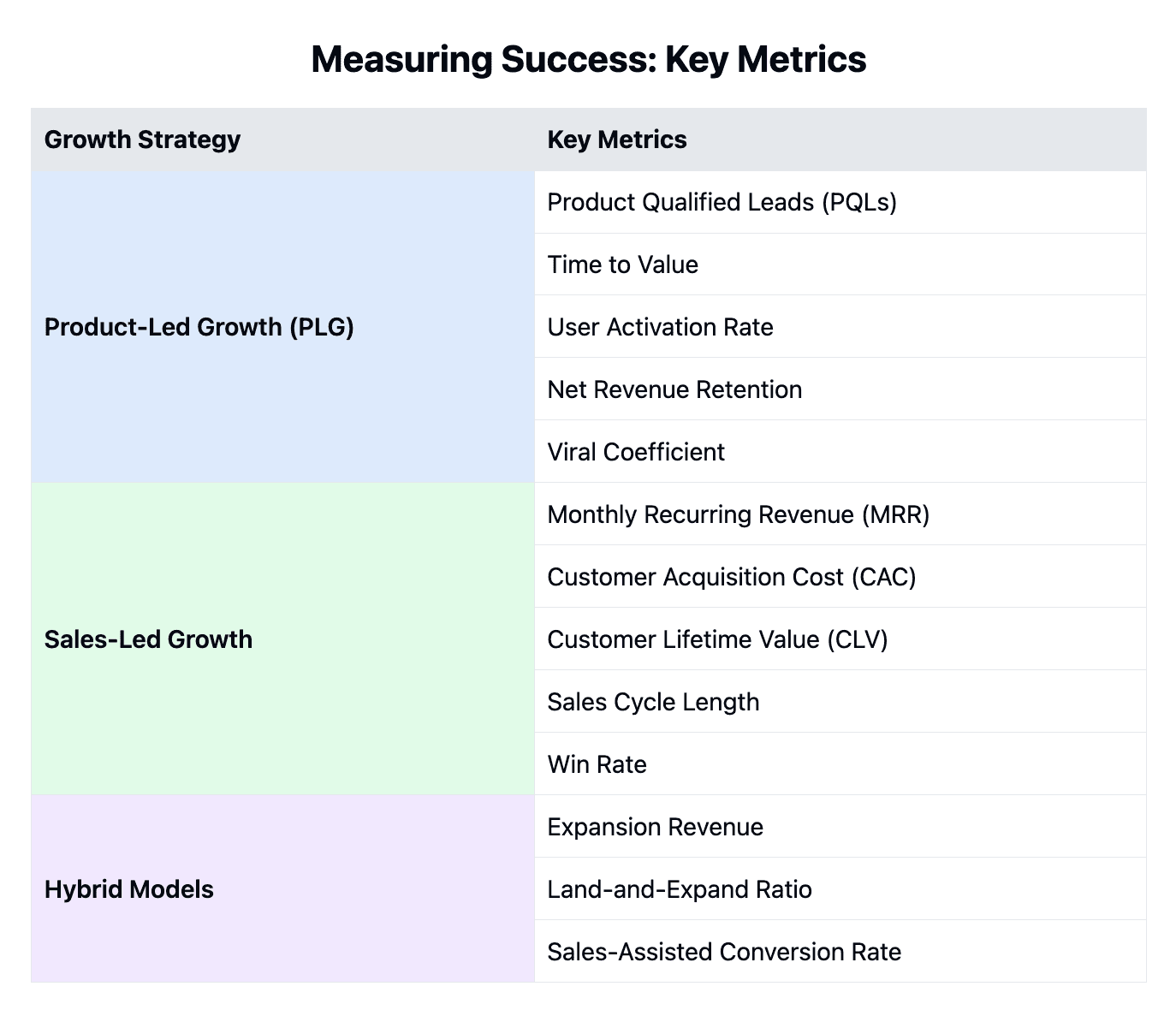
Regardless of the strategy you choose, measuring its effectiveness is crucial. Key metrics to track include:
For PLG:
Product Qualified Leads (PQLs)
Time to Value
User Activation Rate
Net Revenue Retention
Viral Coefficient
For Sales-Led Growth:
Monthly Recurring Revenue (MRR)
Customer Acquisition Cost (CAC)
Customer Lifetime Value (CLV)
Sales Cycle Length
Win Rate
For Hybrid Models:
Expansion Revenue
Land-and-Expand Ratio
Sales-Assisted Conversion Rate
Conclusion
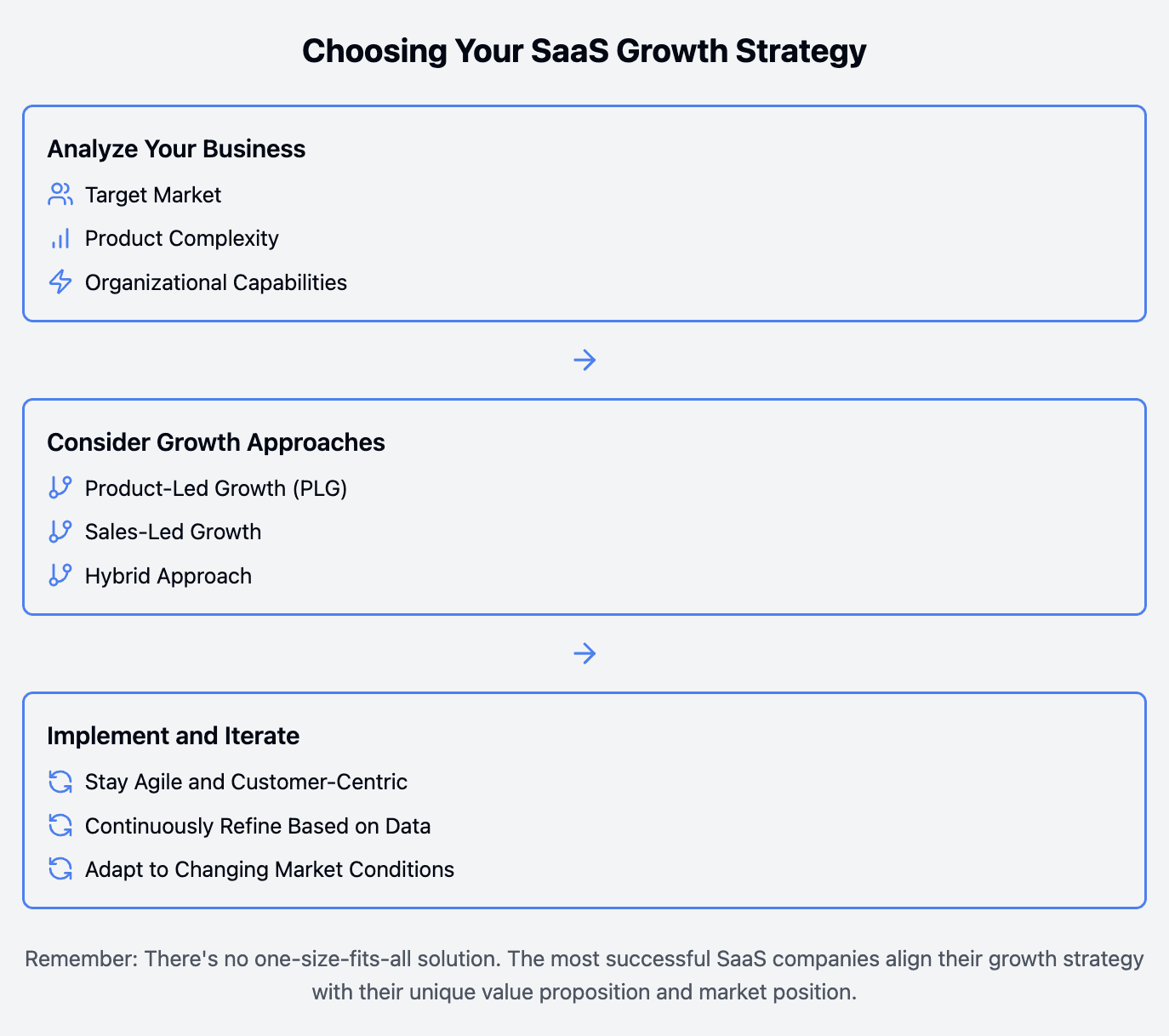
The choice between PLG and sales-led growth—or the decision to adopt a hybrid approach—should be based on a careful analysis of your product, target market, and organizational capabilities. There's no one-size-fits-all solution, and the most successful SaaS companies are those that thoughtfully align their growth strategy with their unique value proposition and market position.
As you evaluate your approach, remember that the SaaS landscape is continually evolving. Stay informed about industry trends, remain agile in your strategies, and always keep your customers' needs at the forefront of your decision-making. By doing so, you'll be well-positioned to achieve sustainable, long-term success in the competitive SaaS market.
Whether you're a startup founder choosing your initial go-to-market strategy or an established SaaS leader looking to optimize your growth approach, the key is to remain customer-centric, data-driven, and open to evolution. The right strategy for your company today may need to be adjusted as you scale, as your product matures, or as market conditions change.
By understanding the nuances of PLG and sales-led growth, you're equipped to make informed decisions that will shape the future of your SaaS business. The journey of growth is ongoing, and the companies that thrive will be those that continuously refine their approach based on customer needs, market dynamics, and their own unique strengths.




